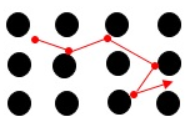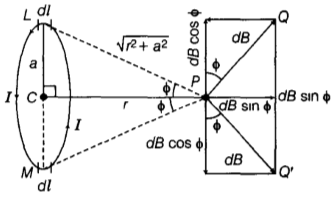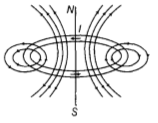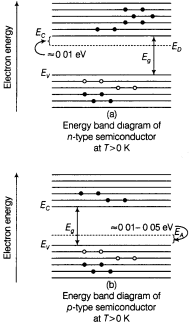Ask questions which are clear, concise and easy to understand.
Ask QuestionPosted by Ankit Patel Chaudhary 6 years, 3 months ago
- 3 answers
Ishani Gupta 6 years, 3 months ago
Misbahul Haque 6 years, 3 months ago
Posted by Anand Dubey 6 years, 3 months ago
- 1 answers
Sia ? 6 years, 3 months ago
The magnetic force acting on a particle of charge q moving with velocity v in a magnetic field B is given by,
F = qvB
{tex} \Rightarrow {/tex} B = {tex}\frac{F}{qv}{/tex}
Let, F = 1N, q = 1C and v = 1 ms-1
{tex} \Rightarrow {/tex} 1T = 1N / (1C)(1 ms-1) = Ns / Cm
Thus, One Tesla is defined as the strength of magnetic field at the point when a charge of 1 Coulomb moving perpendicularly to the direction of magnetic field at a velocity of 1 ms-1 experiences a force of 1 Newton.
Posted by Hussain Sheikh 6 years, 3 months ago
- 1 answers
Ďãřşháñăã Yadav ? ? ? ✊ 6 years, 3 months ago
Posted by Ankit Yadav 6 years, 3 months ago
- 0 answers
Posted by Tushar Sharma 6 years, 3 months ago
- 0 answers
Posted by Mayank Thakur 6 years, 3 months ago
- 1 answers
Posted by Gambheer Sharma 6 years, 3 months ago
- 0 answers
Posted by Shudhanshu Ranjan 6 years, 3 months ago
- 1 answers
Navjot Kaur 6 years, 3 months ago
Posted by Yavana Ranii 6 years, 3 months ago
- 0 answers
Posted by Kiruthiga R 6 years, 3 months ago
- 0 answers
Posted by Ni T I Sh 6 years, 3 months ago
- 1 answers
Yogita Ingle 6 years, 3 months ago
First law: -
- According to the first law an emf is induced in the circuit whenever the amount of magnetic flux linked with a circuit changes.
- Current was induced because of magnetic flux, as there is some current in the circuit therefore there will be some emf flowing in the circuit.
- Whenever the amount of magnetic flux linked with the circuit changes only at that time emf is induced.
Second law: -
- According to the second law the magnitude of the induced emf in a circuit is equal to the time rate of change of magnetic flux through the circuit.
- Emf which is induced will depend upon rate at which the magnetic flux is changing.
Posted by Ďãřşháñăã Yadav ? ? ? ✊ 6 years, 3 months ago
- 1 answers
Sia ? 6 years, 3 months ago

No, the drift speed of electrons is superposed over the random velocities of the electrons and they move in zig- zag path.
Posted by Bharat Rajput 6 years, 3 months ago
- 0 answers
Posted by Bharat Rajput 6 years, 3 months ago
- 0 answers
Posted by Ankit Jalendra 6 years, 3 months ago
- 7 answers
Akriti Trivedi 6 years, 3 months ago
Ďãřşháñăã Yadav ? ? ? ✊ 6 years, 3 months ago
Ďãřşháñăã Yadav ? ? ? ✊ 6 years, 3 months ago
S.....Sharma☺??? .. 6 years, 3 months ago
Ďãřşháñăã Yadav ? ? ? ✊ 6 years, 3 months ago
Posted by Iliyas Ahmad 6 years, 3 months ago
- 0 answers
Posted by Yash Barnwal 6 years, 3 months ago
- 1 answers
Posted by Barathvikneshwaran Saravanan 6 years, 3 months ago
- 1 answers
Sia ? 6 years, 3 months ago
Let us consider a circular loop of radius "a" with centre C. Let the plane of the coil be perpendicular to the plane of the paper and "I" be the current flowing in the direction as shown in the figure (coming out from plane of paper normally at top). Suppose P is any point on the axis at a distance "r" from the centre C.

Now, consider a current element "Idl" on top (L) where the current comes out of paper perpendicularly whereas at bottom (M) the current enters into the plane of paper perpendicularly.
{tex}\because \quad L P \perp I d l{/tex}
Also, {tex}M P \perp I d l{/tex}
{tex}\because \quad L P = M P = \sqrt { r ^ { 2 } + a ^ { 2 } }{/tex}
According to Biot-Savart's law,
The magnetic field at point P due to current element Idl
{tex}d B = \frac { \mu _ { 0 } } { 4 \pi } \cdot \frac { I d l \sin 90 ^ { \circ } } { \left( r ^ { 2 } + a ^ { 2 } \right) }{/tex}
where, a = radius of circular loop,
r = distance of point P from centre and along the axis.
The direction of dB is perpendicular to LP and along PQ, so {tex}P Q \perp L P{/tex}.
Similarly, the value of magnetic field at point P due to current element Idl at the bottom is same and its direction is along PQ', where {tex}P Q ^ { \prime } \perp M P{/tex} .
Let ϕ = the angle between LP and CP.
Now, resolving magnetic field dB into two components, (i) dBsinϕ along the axis and (ii) dBcosϕ normally to the axis.
the components dBcosϕ balance each other and axial components are in same direction so get added. So,
Net magnetic field is given by
{tex}B = \oint d B \sin \phi = \oint \frac { \mu _ { 0 } } { 4 \pi } \left( \frac { I d l } { r ^ { 2 } + a ^ { 2 } } \right) \cdot \frac { a } { \sqrt { r ^ { 2 } + a ^ { 2 } } }{/tex} {tex}\left[ {\because In \Delta PCL,\sin \phi = \frac{a}{{\sqrt {{r^2} + {a^2}} }}} \right]{/tex}
or {tex}B = \frac { \mu _ { 0 } I a ^ { 2 } } { 2 \left( r ^ { 2 } + a ^ { 2 } \right) ^ { 3 / 2 } }{/tex}
For N turns, {tex}B = \frac { \mu _ { 0 } N I a ^ { 2 } } { 2 \left( r ^ { 2 } + a ^ { 2 } \right) ^ { 3 / 2 } }{/tex}Tesla.
Magnetic field lines due to a current carrying loop are given by

Posted by Sheetal Giri 6 years, 3 months ago
- 1 answers
Sia ? 6 years, 3 months ago

The donor energy level ED is just below the bottom of the conduction band. It contains the electrons due to added impurity atoms. At room temperature the electrons easily jump to conduction band and also some electrons from valence band jump to conduction band. It makes the number of electrons more in conduction band than the number of holes in valence band. So conduction takes place due to electrons. Whereas the acceptor energy level EA lies slightly above the top of the valence band. At room temperature, many electrons of the valence band get excited to these acceptor energy levels, leaving behind equal number of holes in the valence band. These holes can conduct current. Thus, the valence band has more holes than the electrons in the conduction band.
Posted by Prince Satyam 6 years, 3 months ago
- 2 answers
Navjot Kaur 6 years, 3 months ago
Sia ? 6 years, 3 months ago
Fleming’s left hand rule states that stretch the forefinger, the central finger and the thumb of your left hand mutually perpendicular to each other. If the forefinger shows the direction of the magnetic field and central finger that of the current, then the thumb will point towards the direction of motion of the conductor.
Posted by Pranshu Shrivastav 6 years, 3 months ago
- 2 answers
Srijan Kumar 6 years, 3 months ago
Srijan Kumar 6 years, 3 months ago
Posted by Teena Rana 6 years, 3 months ago
- 8 answers
Priya Dharshini 6 years, 3 months ago
Ďãřşháñăã Yadav ? ? ? ✊ 6 years, 3 months ago
Aman Kumar 6 years, 3 months ago
Ďãřşháñăã Yadav ? ? ? ✊ 6 years, 3 months ago
Aman Kumar 6 years, 3 months ago
Ďãřşháñăã Yadav ? ? ? ✊ 6 years, 3 months ago
Posted by Neha Guntapeliwar 6 years, 3 months ago
- 1 answers
Sia ? 6 years, 3 months ago
Electric field intensity at a distance r from line charge of density {tex}\lambda {/tex} is
{tex}E = \frac{\lambda }{{2\pi {\varepsilon _0}r}}{/tex}
{tex}\therefore {/tex} Field intensity on negative charge (r = 0.02 m)
{tex}{E_1} = \frac{{4 \times {{10}^{ - 4}} \times 9 \times {{10}^9} \times 2}}{{0.02}} = 3.6 \times {10^8}N/C{/tex}
Force on negative charge
{tex}{F_1} = q{E_1} = 2 \times {10^{ - 8}}\left( {3.6 \times {{10}^8}} \right) = 7.2N{/tex}
It is directed towards the line charge.
Similarly field intensity at positive charge (r = 0.022 m)
{tex}{E_2} = \frac{{4 \times {{10}^{ - 4}} \times 9 \times {{10}^9} \times 2}}{{0.022}} = 3.27 \times {10^8}N/C{/tex}
Force on positive charge
{tex}{F_2} = q{E_2} = 2 \times {10^{ - 8}}(3.27 \times {10^8}) = 6.54N{/tex}
It is directed away from the line charge.
{tex}\therefore {/tex}Net force on the dipole,
F = F1 - F2 = (7.2 - 6.54)N = 0.66 N
F is towards the line charge.

myCBSEguide
Trusted by 1 Crore+ Students

Test Generator
Create papers online. It's FREE.

CUET Mock Tests
75,000+ questions to practice only on myCBSEguide app
 myCBSEguide
myCBSEguide
Rishabh Rathi 6 years, 3 months ago
0Thank You